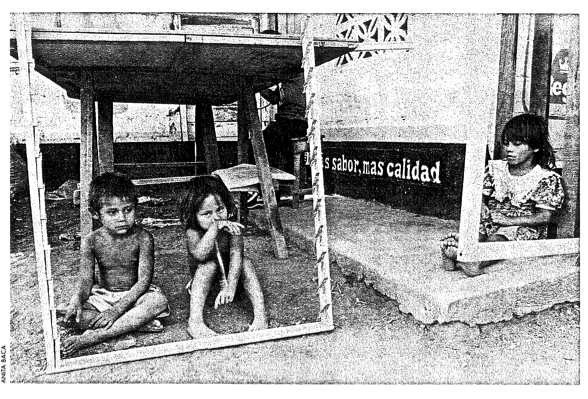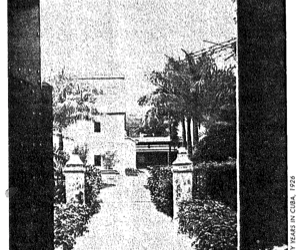El Salvador Challenge
From Peace to Sustainable Development

Central American children are the smallest victims.
Over the past few years, El Salvador has accomplished what can only be described as a political and economic miracle. Peace accords were concluded, ending a decade-long destructive civil war. Political reforms led to democratic elections and peaceful government transitions. Economic reforms have resulted in macroeconomic stability and rapid economic growth.
However, a degraded and dwindling resource base, coupled with serious challenges of mass poverty, could threaten the sustainability of both peace and economic growth in El Salvador, if not promptly and effectively addressed. The country has already lost 98% of its original habitat. Fifty percent of households are below the poverty line, as defined by the World Bank, and the country’s already overburdened urban infrastructure cannot afford faster rates of urbanization. At the same time, with 50% of the country’s population under 20 years of age, El Salvador is facing massive entry into the labor force, a trend likely to continue well into the 21st century. El Salvador’s current economic structure cannot sustainably assimilate the high population growth rate. The rural resource base and the urban environment, both under severe strain already, would suffer further encroachment and degradation if the new entrants into the labor force do not find gainful employment in non-resource-based, labor-intensive, export-oriented sectors.
El Salvador’s challenge is how to regulate economic activity, address market inefficiencies and protect the environment without harming competitiveness, stifling investment, or introducing burdensome regulations. The country must find ways to invest in environmental improvement and social development without compromising fiscal discipline, enlarging bureaucracy, or jeopardizing economic growth.
The problems are immense. Poor access to water and sanitation exacts a high toll on human health and productivity. About 12,000 children die each year from preventable diarrheal diseases related to contaminated drinking water, poor hygiene, contaminated food and uncollected/untreated sewage and solid waste acting synergistically with poor nutrition and inadequate health care. Diarrheal diseases are implicated in 50% of the deaths of infants from one to twelve months and in one-third of the deaths of children from one to five years. Despite an annual rainfall of 1800 millimeters per year and a physical abundance of water (the Lempa River watershed is Central America’s largest), El Salvador suffers from severe economic shortage of water due to wasteful use and mismanagement. In 1990, over 85% of the available surface water of 677 cubic meters per second was needed to assimilate the municipal and industrial wastes dumped untreated into rivers and lakes, leaving little to cover the country’s estimated “demand” of 408 cubic meters per second. One in four rural residents has no sanitary facilities, and almost none is connected to sewage pipes.
Natural forest cover is down to 2% of the country’s land area, one of the lowest in the world, and is clearly inadequate to maintain ecological stability. A quarter of farm fields suffer from high rates of soil erosion, and about one-fifth of them experience significant productivity losses. Watersheds and agricultural lands are under severe pressure from unsustainable farming practices and excessive fuelwood harvesting. While 70% of the population depends on fuelwood for energy and the country’s hydroelectric infrastructure is under risk from deforestation, there is hardly any reforestation effort.
With 90% of rural households burning fuelwood in poorly ventilated stoves, 3.7 million people are exposed to high levels of indoor pollution, which results in three times as many deaths and respiratory incidents as outdoor pollution. Overall respiratory illness is a factor in the deaths of about 11,000 children each year. Over one-half of all the children under five experience a respiratory infection in any given two-week period.
Finally, while the country still has representative areas of the original ecosystems such as tropical dry, montane, coniferous, and cloud forests, mangroves, and coral reefs, and its mammal and bird species are comparable to those of other countries in the region, they are far more vulnerable. Maintaining sustainable populations of these species will require serious efforts to preserve the last remaining natural areas of the country and the creation of corridors joining them with larger protected areas in neighboring countries.
A preliminary, partial, and conservative estimate of the costs of environmental degradation to the Salvadoran economy and society lies in the range of US$ 300-400 million per year or 3-4% of the country’s gross domestic product. This estimate includes only the health losses from water and air pollution and the productivity losses from soil erosion and sedimentation of hydroelectric reservoirs and other water bodies. It does not include material damages from air pollution, fishery losses from water pollution and overfishing, damages to infrastructure from water pollution and sedimentation, loss of timber, other forest products and biodiversity due to deforestation, or the loss of potential tourism and recreation benefits. While lack of adequate data prevented detailed valuation of these losses, fragmented information and experience from other countries suggests that these losses are unlikely to fall below $200 million per year, bringing the total estimated losses to around US$ 500 million per year or 5% of the country’s GDP, a figure comparable to estimates attained from other countries that experience similar levels of environmental neglect.
Following is a set of actions that can be initiated immediately and begin to make a difference in the lives of all Salvadorans and the environment in which we live. These are actions that would increase access to safe water and sanitation, reduce indoor and outdoor air pollution, and help farmers maintain productivity and improve their incomes while helping reforest critical watersheds and protect the country’s energy and water supply infrastructure.
o raise water prices to cover the full cost of supply for 100% coverage
o privatize solid waste collection to lower cost and raise efficiency
o phase out the diesel subsidy for public buses
o institute a self-monitoring scheme for industrial pollutants with mandatory public reporting requirements;
o encourage private sector and NGO initiatives to educate the rural population on the harmful effects of indoor air pollution and to promote more efficient stoves and alternative fuels
o reform forestry regulations to promote private sector participation and to provide communities with incentives to protect the forests
o actively pursue joint implementation opportunities and participate in emerging carbon markets
o introduce economic instruments such as pollution taxes to internalize the environmental costs of economic activity
In addition to these policies and actions that can be initiated or encouraged by the government but carried out mostly by the private sector, local communities and the civil society, there are countless other opportunities for immediate action by individual businesses, community leaders, NGOs, and civic-minded citizens that do not require prior government action. The success stories of NGO and community initiatives are many, ranging from EDUCO’s community-managed education to Salva Natura’s management of protected areas, to ECO-OK coffee certification program (Certified Ecologically Grown Product) and community action to clean and protect the Ilopango and Coatepeque lakes. Private sector initiatives also abound, ranging from Sherwin Williams’ and Izalco’s waste minimization and treatment to PROCAFE’s environmental self-monitoring and the private-sector promoted ecoefficiency centers. The scope for more of such initiatives is immense, and needs abound in El Salvador’s environmental hot spots of Rio Sucio, Rio Acelhuate, Rio Lempa, Lago Ilopango, the volcanic slopes around San Salvador, the biological corridors, and the Gulf of Fonseca, among others.
There are encouraging signs. A Ministry of Environment was recently established and an activist Minister was appointed to head it. A framework environmental law has recently passed through the National Assembly and for the first time, the government is working closely with a wide spectrum of NGOs, and the private sector to address pressing environmental issues. Still, a lot more remains to be done to meet El Salvador’s challenge to turn a fragile peace into sustained development.
Fall 1998
Theodore Panayatou is an Institute Fellow and Director of the International Environment Program at the Harvard Institute for International Development, as well as a Lecturer on Economics at the Kennedy School of Government.
Related Articles
The Cienfuegos Botanical Garden
The Cienfuegos Botanical Garden, about three-quarters of an hour outside the Cuban city of Cienfuegos at the “Pepito Tey” sugar complex, welcomes visitors to a park-like setting of palms…
La Planada
Guillermo Cantillo was sitting on the porch of the administrative offices at La Planada, Colombia, where I found him enjoying a sunny afternoon. He remarked that we had to take advantage of…
Environmental Ethics and Latin America
Environmental issues have become a central focus of public policy in the United States and around the world.The countries of Latin America know from experience that environmental…




